Captivating Traditions of Saunas and Bathhouses: Discover Global Rituals

Updated On: April 16, 2024 by Fatma Mohamed
Saunas and bathhouses have served as pillars of wellness and socialisation across the globe for centuries. From the steamy hammams of Türkiye to the serene onsen of Japan, these institutions offer a window into the customs and daily life of various cultures. The tradition often extends beyond mere personal hygiene, playing a significant role in health, relaxation, and community bonding. The architecture and design of these facilities can be simple or elaborate, but each is reflective of the environment and traditions it springs from.

Throughout history, the sauna and bathhouse experience has been deeply ingrained in rituals and regional practices. In Finland, the sauna is a place of tranquillity and connection, almost sacred in its cultural weight. On the other side of the world, the Native American sweat lodge serves as a spiritual ceremony for purification. These places are more than just locations for bathing; they are social venues, therapeutic spaces, and even sites of ritualistic significance. Despite the diversity, each retains a unifying theme: the pursuit of cleansing, well-being, and communal interaction.
Table of Contents
Historical Origins of Saunas and Bathhouses
We explore the fascinating past of saunas and bathhouses, shedding light on how these traditions have been integral parts of various cultures for centuries. From the ancient Roman and Greek practices to the iconic Finnish sauna experiences, each has its own story and significance.
Ancient Roman and Greek Traditions
Initially, the concept of public bathhouses emerged in Ancient Rome, serving as central hubs for socialising, relaxation, and cleanliness. Romans constructed sophisticated systems of aqueducts and sewage, enabling them to develop thermal baths. Structures like the Stabian Baths found at Pompeii illustrate how integral these facilities were to Roman society, featuring rooms with varying temperatures known as the caldarium, tepidarium, and frigidarium.
Nordic and Finnish Beginnings
In contrast, Nordic regions, particularly Finland, are renowned for their saunas, which have roots dating back over 10,000 years. The Finnish sauna is a tradition deeply embedded in daily life, beginning as simple pits dug into a hillside, evolving into the wooden cabins heated with a kiuas (stove) that we recognise today. These structures provided warmth and were essential for health and hygiene during the harsh Finnish winters.
Influence of Turkish and Moroccan Hammams
By the 15th century, the influence of the Turkish hammam was substantial, stemming from Roman bath culture but infused with Central Asian Turkish tradition. It served as a place for ritual cleansing, social interaction, and relaxation. Similar to the Roman approach, the Turkish hammam featured progressively heated rooms where visitors would sweat and receive massages. In Morocco, these spaces are referred to as Moroccan hammams, maintaining a central role in community life to this day.
Cultural Significance Across Regions
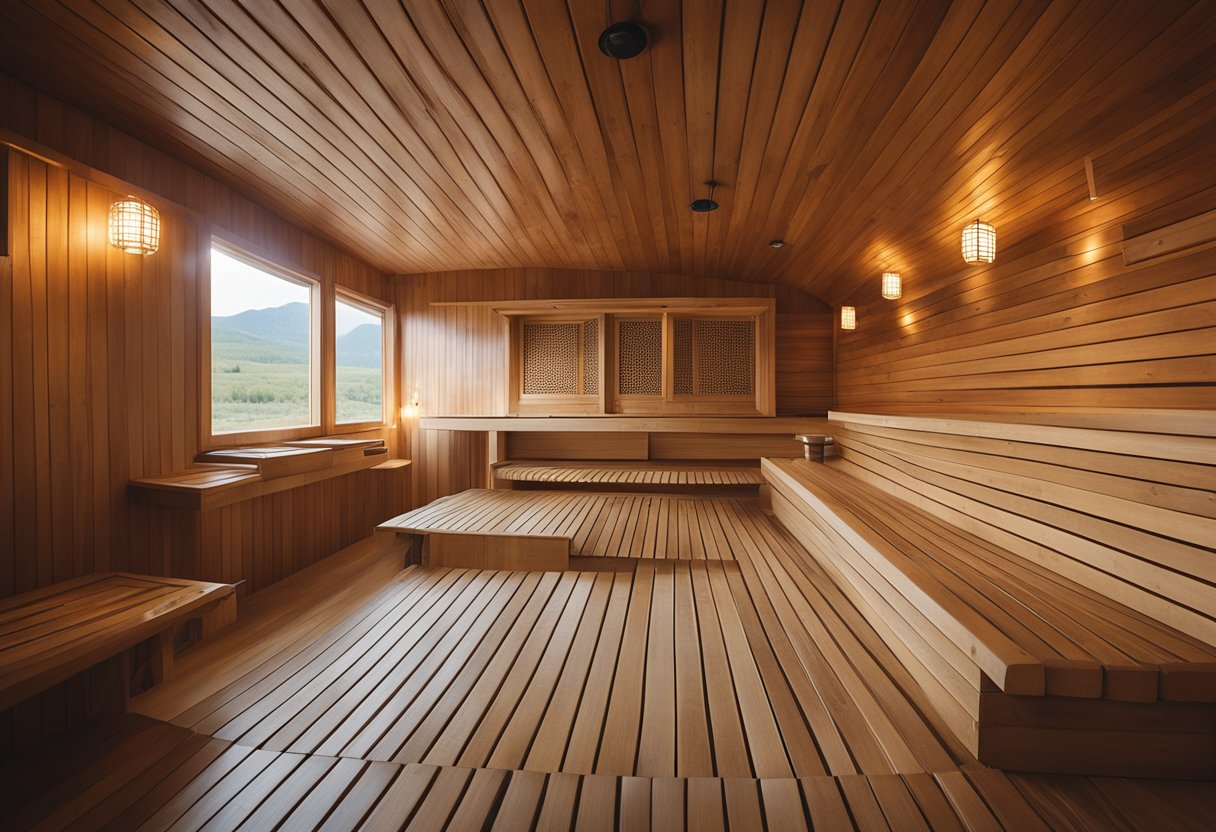
In various parts of the world, the practices of saunas and bathhouses embody deep-rooted cultural traditions. These communal spaces offer more than just a place to cleanse; they serve as social hubs and are integral to the wellness practices of many societies.
Public Bathhouses in Asia
In Korea, jjimjilbangs, a type of public bathhouse, date back to the 15th century. These spaces are central to Korean culture, providing a place for relaxation and communal bathing. Over in Japan, the tradition of onsens, or hot springs, is similarly ancient and remains a beloved part of Japanese culture to this day, offering both therapeutic benefits and social engagement.
Sauna Traditions in Europe
Europe presents a diverse tapestry of bathing traditions. The Finnish sauna stands out as a cornerstone of Finnish culture, emblematic of a lifestyle underscored by wellness and simplicity. In Russia, the banya represents a critical element of Russian heritage, combining high-temperature steam baths with social norms that foster community bonding.
Native American Sweat Lodges
Native American tribes across North America have upheld the tradition of the sweat lodge, a space synonymous with spiritual cleansing and healing. These structures are of immense cultural significance, facilitating ceremonies that are crucial to the social and spiritual fabric of the communities.
Architectural and Design Elements
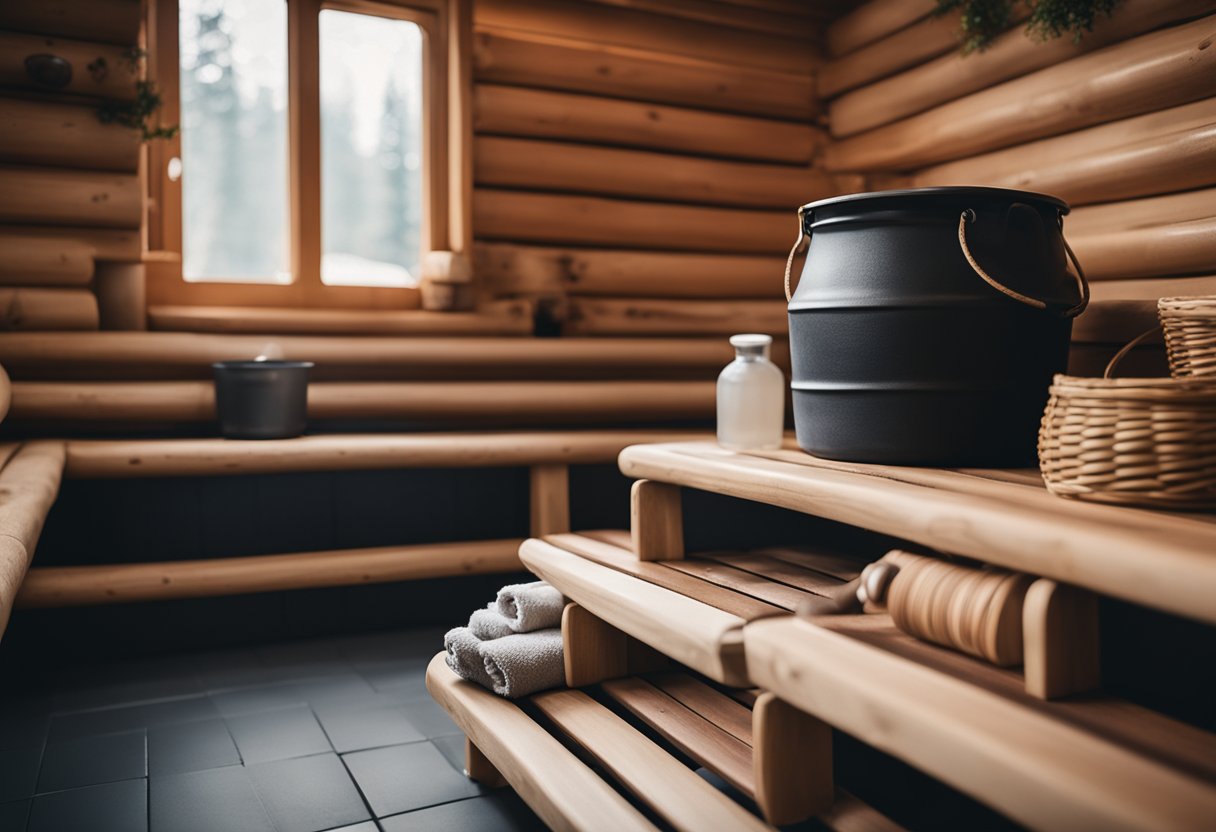
The design of saunas and bathhouses is deeply rooted in cultural traditions, reflecting the importance of these structures in societies around the world. Types range from the Finnish sauna to the Japanese onsen, each with unique architectural features.
Structure and Materials
- Finnish Sauna: Traditionally constructed from wood, Finnish saunas are known for their log cabin appearance. Insulation is key, with wooden benches situated at different levels to utilise the rising heat. Large stones are often used in the heater to retain and gently release heat.
- Japanese Bathhouse (Onsen): Onsen are typically made from natural stone and wood, harmonising with their serene settings. The use of local materials helps these bathhouses blend into the landscape, creating an environment where architecture and nature coexist.
Materials such as stone and wood are not only chosen for their aesthetic appeal but also for their ability to handle the high heat and humidity that characterises bathhouses around the world.
Heating Techniques
- Wood-Fired: Applied in many traditional saunas, this technique involves a wood-burning stove to heat stones. Smoke from the stove circulates inside, contributing to the distinct atmosphere and aroma.
- Smoke Sauna: A variant of the wood-fired sauna is the smoke sauna, where a fire is lit directly under the stones with no chimney. The room is allowed to fill with smoke, which is later ventilated, leaving behind a unique scent and deep heat.
Contemporary bathhouses and saunas also employ varied heating methods to provide an enduring experience of warmth and relaxation.
The Sauna and Bathhouse Experience
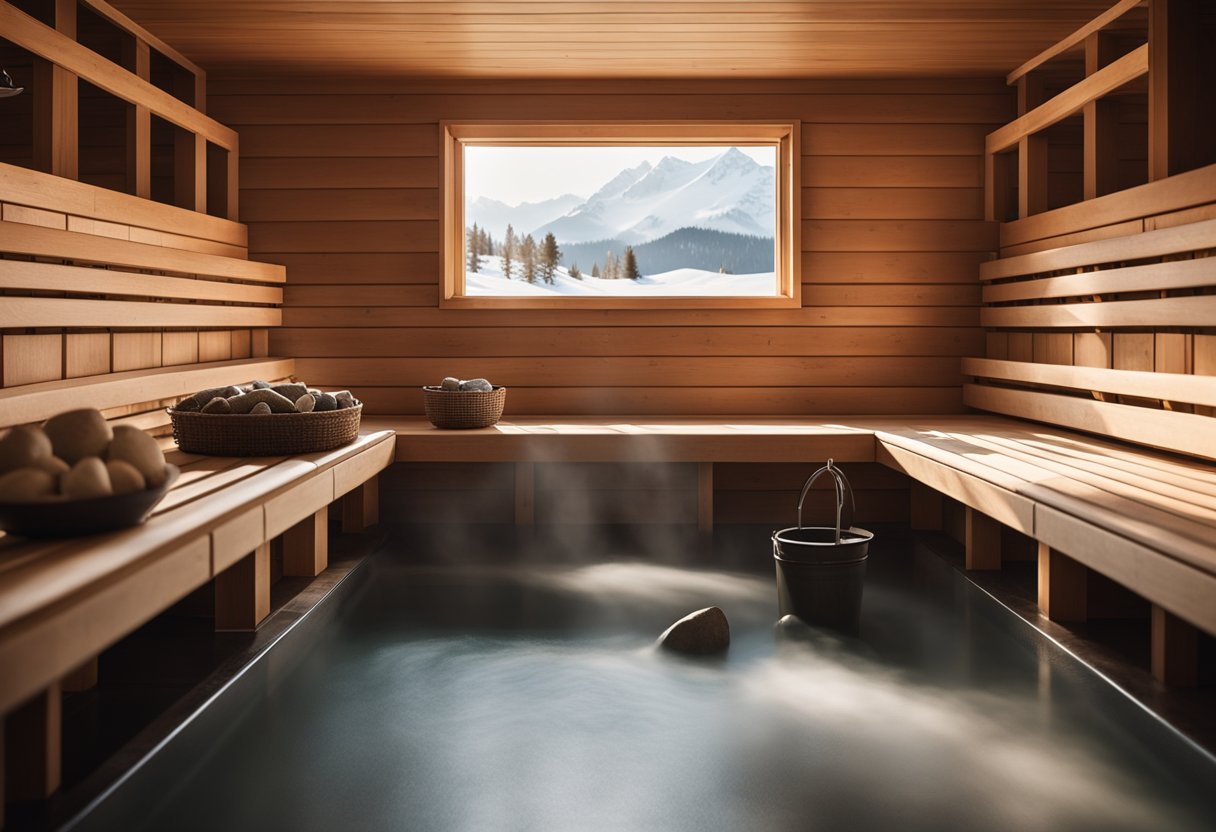
In our exploration of global wellness traditions, we experience a tapestry of sauna and bathhouse rituals that stand as a testament to cultural relaxation and purification practices.
Traditional Rituals and Procedures
In the heart of the sauna experience, löyly—the steam that emanates when water is thrown over heated stones—plays a central role. This practice, deeply rooted in Finnish culture, involves a gradual increase in temperature and humidity within the sauna, crafting an environment ideal for both relaxation and detoxification. Venik, clusters of leafy branches, are traditionally used in Russian banyas to massage and stimulate the skin, promoting blood circulation.
- Temperature: Gradually increases to around 70-100 degrees Celsius.
- Water: Essential for creating löyly (steam) by being splashed onto hot stones.
- Stones: Retain heat and are central to the sauna’s design; often, specific types are chosen for their heat retention properties.
Bathers might commence their session by sitting or reclining on mats to protect themselves from the intense heat of the wooden benches. This is interspersed with cooldown periods, which may include immersing in cold water or taking a rest in a cooler environment.
Modern Adaptations and Innovations
Today’s wellness landscapes often weave traditional practices with current health trends. A resurgence in the importance of saunas and bathhouses across the globe integrates sage and other herbs for their aromatic properties, enhancing the holistic experience. From the incorporation of salt, ice, or mineral-infused steam to the application of modern massage techniques, these spaces have evolved to cater to contemporary desires for well-being and leisure.
- Massage: Expands on traditional methods, including options like aromatherapy and hot stone massage.
- Innovations: Include infrared saunas and steam injections for an enhanced experience.
Modern adaptations have not only retained the essence of traditional rituals but have also amplified the sensory experience, offering guests both the wisdom of the past and the comforts of the present. Whether it’s the traditional heat of Finnish saunas or the innovative offerings in spa resorts, the core objective remains—to offer tranquillity and health benefits through the interaction of heat, steam, and expert techniques.
Health and Wellness Benefits
In the world of saunas and bathhouses, we find a multitude of health and wellness benefits that stem from the traditions of using heat for healing and hygiene.
Therapeutic Effects of Heat
Heat therapy has long been associated with healing and relaxation. Frequent sauna bathing may lead to a decrease in blood pressure and improvement in heart function, as the heat promotes circulation and can induce a state akin to mild exercise. Studies highlight that engaging in regular sauna sessions can be beneficial for vascular health, potentially lowering the risk of high blood pressure and cardiovascular diseases.
Skin and Hygiene
The steam and heat of a sauna serve a dual purpose for skin and hygiene. Sauna bathing can act as a deep cleanse, opening up pores and helping in the removal of impurities from the skin. This process not only aids in improving skin health but also promotes better hygiene. The heat can also encourage skin renewal, leaving it more supple and potentially improving the appearance and elasticity of your skin.
Social and Communal Aspects
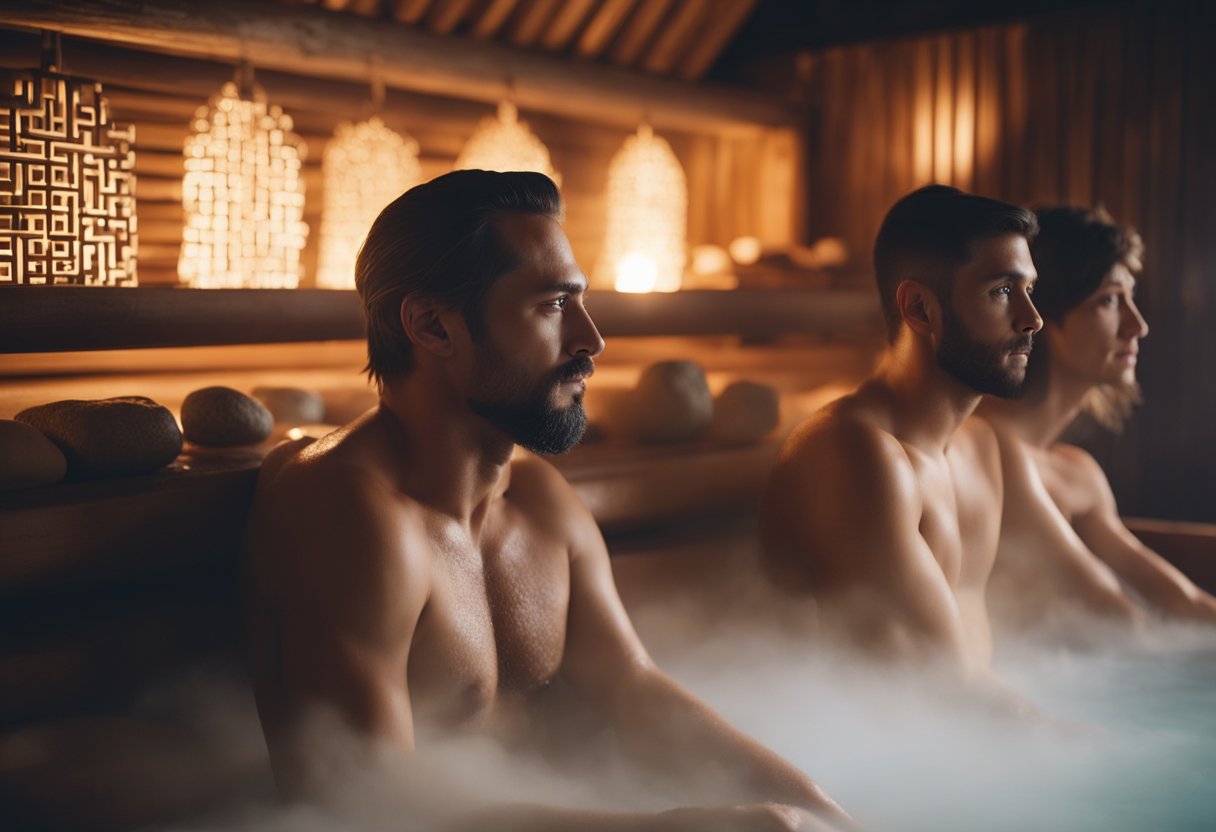
The social and communal aspects of saunas and bathhouses are integral to understanding their cultural significance. These spaces serve not only as places of personal cleansing and health but also as sites for social interactions and community bonding.
Public vs Private Spaces
Public bathhouses are often the epicentre of social life in many cultures. Here, individuals from various strata of society come together to socialise and engage in communal activities. For instance, in Finland, with a rich tradition of sauna culture, public saunas are a core component of community life, giving way to dialogues and fostering a sense of togetherness. On the contrary, private saunas within homes are spaces for personal relaxation or intimate gatherings, reflecting a different social dynamic.
Gender Dynamics and Family Involvement
Gender dynamics within saunas and bathhouses are culturally specific. In some societies, there is a strong tradition of gender segregation, with specific hours or spaces dedicated solely to women or men. The family’s involvement in these traditions varies, with some bathhouses offering family sessions where modesty and nudity norms adjust to accommodate the presence of all ages. In others, such as certain Finnish saunas, gender-segregated moments coexist with mixed sessions, influencing how one socialises and engages within these spaces. Health benefits remain a driving force behind family involvement as it’s viewed as crucial for all generations.
Rituals and Traditions

The rich tapestry of sauna and bathhouse rituals reflects unique cultural insights and spiritual understandings related to purification and health.
From Löyly to Aufguss
In the heart of sauna culture lies löyly, the Finnish word for the steam that’s released when water is poured over hot stones in a sauna. This practice is not only about the physical sensation of heat but also encapsulates a deep connection to nature and wellness. Each splash of water increases humidity, intensifies the heat, and is said to improve circulation and detoxify the body through sweating.
The German equivalent, Aufguss, involves a sauna master distributing heat by waving a towel, enriching the experience with essential oils that invigorate the senses. This tradition transforms the sauna into a place of communal relaxation and rejuvenation, sometimes accompanied by music or thematic storytelling for an immersive experience.
Spiritual and Purification Practices
Sauna traditions often extend beyond physical cleansing, incorporating spiritual and purification rituals that are integral to various cultures across the world. For instance, in Mexico, the Temazcal ceremony is a pre-Hispanic ritual that uses steam and herbal infusions in a dome-shaped structure to purify the body and mind, offering a spiritual cleanse that is believed to reconnect individuals with the earth and their inner self.
In many traditions, the act of sweating is not merely physiological; it is a form of release, allowing participants to expel not only toxins but also emotional and spiritual impurities. This purification process is revered, carrying the potential for transformative experiences that resonate on a deeply personal level.
Global Variations and Adaptations

In this section, we’ll explore the unique types of saunas and bathhouses that reflect the cultural identities of various countries and the way these traditions have transformed over time.
Country-Specific Sauna Types
- Finland: Known for inventing the sauna, one cannot discuss this topic without mentioning Finnish löyly, the steam that comes from throwing water on hot stones. It’s central to the traditional Finnish sauna experience.
- Russia: Russians have their own version known as the banya, which typically combines the high heat of a sauna with steam generated by water on hot rocks.
- Japan: The onsen and sento are two distinct types of Japanese bathhouses. Onsens are natural hot springs, while Santos are public bathhouses using heated tap water.
- Korea: The Korean jjimjilbang is a large, gender-segregated public bathhouse featuring hot tubs, showers, salt, jade, clay, and ice saunas.
- Türkiye: The Turkish hammam focuses on water rather than steam, with an emphasis on full-body wash and massage.
- USA and Mexico: These countries have adapted sauna cultures from immigrants and indigenous practices, resulting in a unique blend, such as sweat lodges that echo Native American traditions.
Evolution of Bathhouse Practices
Bathhouse traditions have not remained static, adapting through time to blend with contemporary lifestyles. These adaptations can be seen in:
- How practices are integrated: For example, in the USA, wellness trends often incorporate elements of sauna-going, focusing on health and relaxation benefits.
- Modern designs: Many countries have modernised traditional designs to suit urban environments and personal preferences. High-end spas in various countries now often include their interpretations of saunas and hammams.
- Cultural shifts: In Finland, the sauna has remained an integral part of life. However, its use has expanded beyond cleansing to become a space for socialising and even conducting business meetings.
- Resurgence and preservation: In places like Korea and Türkiye, there’s a growing trend to preserve and restore traditional bathhouses as a way to sustain cultural heritage amidst global modernisation.
Regulations and Safety Considerations
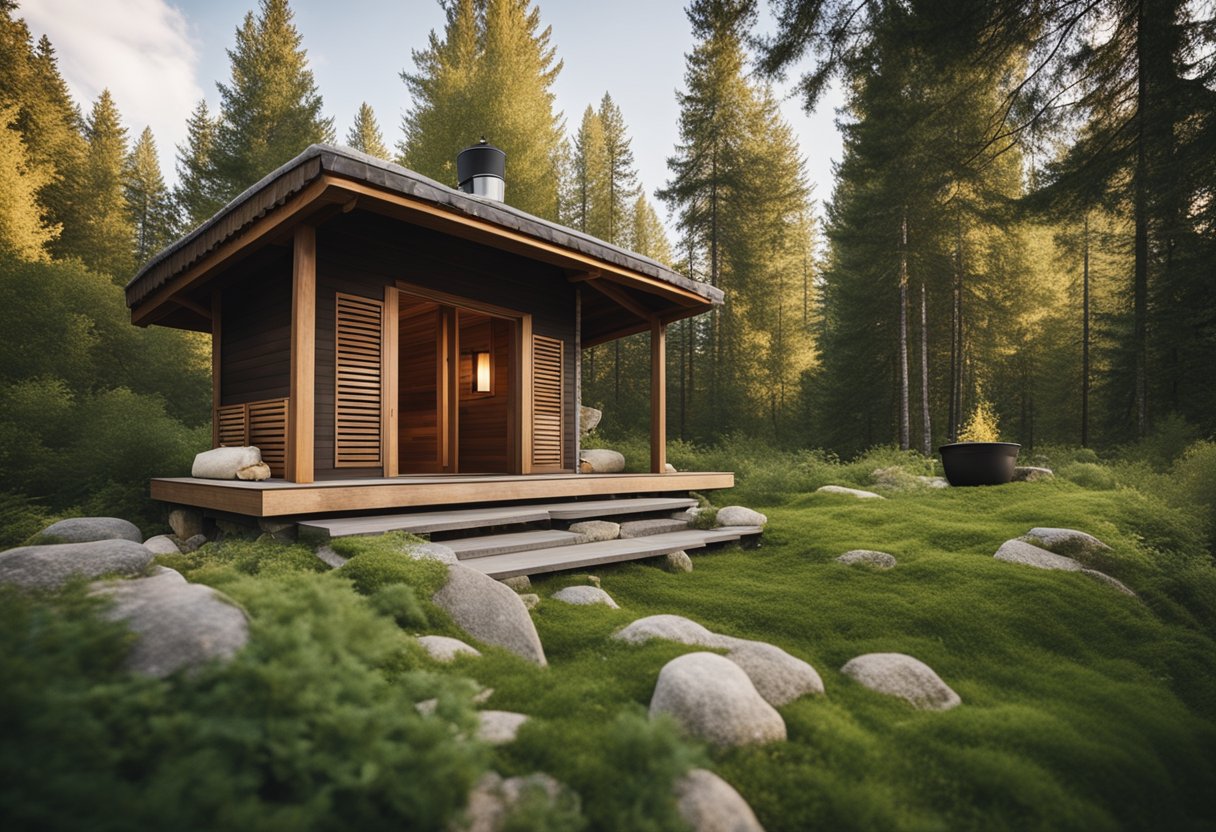
In this section, we discuss the critical aspects of safety and regulatory measures that are essential for sauna and bathhouse experiences. Specifically, we’ll explore the importance of temperature control and the need to stay hydrated alongside recommended time limits to ensure a safe and healthy experience.
Temperature Control and Monitoring
Maintaining the correct temperature is paramount for a safe sauna experience. Regulations often stipulate that saunas should operate within a specific temperature range, typically between 70°C and 100°C. It is vital to have a reliable thermometer in place to consistently monitor these temperatures, ensuring they remain within safe limits for users.
Hydration and Time Limits
A key aspect of sauna safety is managing hydration. Due to the intense heat, it’s important to drink water before, during, and after a sauna session to replace fluids lost through sweating. Regarding time limits, it’s generally recommended not to exceed 15 to 20 minutes at a time inside a sauna. Prolonged exposure can lead to overheating and dehydration, so taking regular breaks to cool down is advised for all users.
Future of Sauna and Bathhouse Culture

As enthusiasts of global wellness traditions, we see an exciting horizon for sauna and bathhouse culture influenced by innovation and sustainability.
Technological Advancements
The future beckons innovative integration of technology into sauna and bathhouse experiences. We anticipate cutting-edge smart systems that automate temperature control and humidity levels, offering a more customised wellness journey. Imagine intelligent wearables that monitor personal health metrics and adjust the sauna environment accordingly for optimal relaxation and health benefits.
Sustainability and Environmental Impact
Saunas and bathhouses are set to embrace sustainability, prioritising minimal environmental impact. This includes the adoption of renewable energy sources like solar panels and biomass heaters. Water conservation methods and the use of eco-friendly materials in construction will become standard practice. By championing sustainability, we ensure that the tradition of saunas and bathhouses contributes positively to the environment and wellness sector.
Frequently Asked Questions

In this section, we address some of the most commonly asked questions about the tradition of saunas and bathhouses around the world.
What historical purposes did bathhouses serve in different cultures?
Historically, bathhouses played critical roles in various cultures, often as centres for social interaction and ritual cleansing. The Turkish Hammams, for instance, stemmed from Roman bath culture, serving not only for personal hygiene but also as social hubs where people gathered for relaxation and various ceremonies.
How does the legality of bathhouses vary across the globe?
The legality of bathhouses varies greatly, depending on the country and its local laws and customs. While some countries uphold them as a precious cultural heritage, in other places, bathhouses may face restrictions or regulations due to contemporary social norms or health concerns.
Which are some of the oldest saunas still in use today?
Some of the oldest saunas still in use include those found in Finland, where the sauna tradition is a fundamental part of life. Finland is believed to be the home of the first saunas, and many traditional Finnish saunas, dating back hundreds of years, are still operational.
In what ways do various countries embrace sauna culture?
Countries worldwide have embraced sauna culture in ways that reflect their unique traditions and climates. In Scandinavia, saunas often involve a hot-cold cycle, contrasting a hot sauna session with a dip in a cold lake. Countries such as Japan and Korea have their distinct bathing practices, such as the onsen and jjimjilbang, which are often frequented for both health and social purposes.
How have traditional saunas and bathhouses evolved over time?
Traditional saunas and bathhouses have evolved from mere cleansing spaces to facilities offering therapeutic and wellness treatments. Some, like the Scandinavian saunas, have expanded their function to include therapies like massage, while others have become part of luxurious spa experiences, incorporating modern amenities while preserving cultural essence.
Can you outline the cultural significance of bathhouses in society?
Bathhouses hold significant cultural importance in many societies. They are places where people congregate for physical and mental rejuvenation, social interaction, and participation in time-honoured traditions. In some cultures, the bathhouse is not only a place for bathing but also a venue where important milestones and community events are celebrated.






